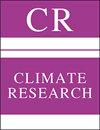Climate resilience of irrigated quinoa in semi-arid West Africa
IF 1.6
4区 地球科学
Q4 ENVIRONMENTAL SCIENCES
引用次数: 1
Abstract
Quinoa (Chenopodium quinoa Willd.) is a herbaceous C3 crop that has demonstrated resilience in regions concurrently affected by climate change and food insecurity, such as sub-Saharan Africa (SSA). The photosynthetic rate and productivity of C3 crops are enhanced under increasing CO2 concentrations. We looked at future climate trends in SSA to estimate their impacts on quinoa yields in Burkina Faso. Climate projections show a temperature increase of 1.67-4.90°C under Representative Concentration Pathways (RCP) 4.5 and 8.5, respectively by the end of the century. We demonstrate that any further climate disturbances can either be beneficial or harmful for quinoa, and modulating climate risks will depend on the decisions made at the farm level (e.g. planting date and crop choice). Crop modelling supports the identification of the most suitable transplanting dates based on future climate conditions (RCP 4.5 and 8.5), agroclimatic zones (Sahel, Soudano-Sahelian and Soudanian) and time-horizons (2020, 2025, 2050 and 2075). We show that quinoa yields can improve—when grown under irrigated conditions and transplanted in November—by about 14-20% under RCP 4.5 and by 24-33% under RCP 8.5 by 2075 across the Sahel and Soudanian agroclimatic zones, respectively. For the Soudano-Sahelian zone, the highest yield improvements (19%) are obtained when transplanting is assumed in December under RCP 8.5 by 2075. Overall, the findings of this work encourage policymakers and agricultural extension officers to further promote climate-resilient and highly nutritious crops. Such possibilities are of much interest in SSA, thought to be highly vulnerable to climate change impacts where millions of people are already experiencing food insecurity.半干旱西非灌溉藜麦的气候适应能力
藜麦(藜麦野生)是一种草本C3作物,在同时受到气候变化和粮食不安全影响的地区,如撒哈拉以南非洲(SSA),已显示出适应力。C3作物的光合速率和生产力随CO2浓度的增加而提高。我们研究了SSA未来的气候趋势,以估计它们对布基纳法索藜麦产量的影响。气候预估显示,在代表性浓度路径(RCP) 4.5和8.5下,到本世纪末温度将分别升高1.67-4.90°C。我们证明,任何进一步的气候扰动都可能对藜麦有利或有害,调节气候风险将取决于农场层面的决策(例如种植日期和作物选择)。作物模型支持根据未来气候条件(RCP 4.5和8.5)、农业气候带(萨赫勒、南达诺-萨赫勒和苏丹气候带)和时间段(2020年、2025年、2050年和2075年)确定最合适的移植日期。我们表明,到2075年,在萨赫勒和苏丹的农业气候带,如果在灌溉条件下种植并在11月移植,藜麦的产量在RCP 4.5和RCP 8.5下分别可以提高约14-20%和24-33%。对于南达诺-萨赫勒地区,到2075年在RCP 8.5条件下假设12月移栽,可获得最高的产量提高(19%)。总的来说,这项工作的发现鼓励政策制定者和农业推广官员进一步推广具有气候适应性和高营养的作物。撒哈拉以南非洲对这种可能性非常感兴趣,该地区被认为极易受到气候变化的影响,数百万人已经在经历粮食不安全。
本文章由计算机程序翻译,如有差异,请以英文原文为准。
求助全文
约1分钟内获得全文
求助全文
来源期刊

Climate Research
地学-环境科学
CiteScore
2.90
自引率
9.10%
发文量
25
审稿时长
3 months
期刊介绍:
Basic and applied research devoted to all aspects of climate – past, present and future. Investigation of the reciprocal influences between climate and organisms (including climate effects on individuals, populations, ecological communities and entire ecosystems), as well as between climate and human societies. CR invites high-quality Research Articles, Reviews, Notes and Comments/Reply Comments (see Clim Res 20:187), CR SPECIALS and Opinion Pieces. For details see the Guidelines for Authors. Papers may be concerned with:
-Interactions of climate with organisms, populations, ecosystems, and human societies
-Short- and long-term changes in climatic elements, such as humidity and precipitation, temperature, wind velocity and storms, radiation, carbon dioxide, trace gases, ozone, UV radiation
-Human reactions to climate change; health, morbidity and mortality; clothing and climate; indoor climate management
-Climate effects on biotic diversity. Paleoecology, species abundance and extinction, natural resources and water levels
-Historical case studies, including paleoecology and paleoclimatology
-Analysis of extreme climatic events, their physicochemical properties and their time–space dynamics. Climatic hazards
-Land-surface climatology. Soil degradation, deforestation, desertification
-Assessment and implementation of adaptations and response options
-Applications of climate models and modelled future climate scenarios. Methodology in model development and application
 求助内容:
求助内容: 应助结果提醒方式:
应助结果提醒方式:


